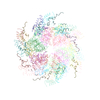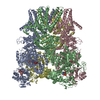+ Open data
Open data
- Basic information
Basic information
| Entry | Database: PDB / ID: 6emw | ||||||
|---|---|---|---|---|---|---|---|
| Title | Structure of S.aureus ClpC in complex with MecA | ||||||
 Components Components |
| ||||||
 Keywords Keywords | CHAPERONE / AAA+ protein / unfoldase | ||||||
| Function / homology |  Function and homology information Function and homology informationstress response to cadmium ion / stress response to copper ion / peptidase activity / cellular response to heat / protein-macromolecule adaptor activity / ATP hydrolysis activity / proteolysis / ATP binding / cytoplasm Similarity search - Function | ||||||
| Biological species |  | ||||||
| Method | ELECTRON MICROSCOPY / single particle reconstruction / cryo EM / Resolution: 11 Å | ||||||
 Authors Authors | Carroni, M. / Mogk, A. / Bukau, B. / Franke, K. | ||||||
 Citation Citation |  Journal: Elife / Year: 2017 Journal: Elife / Year: 2017Title: Regulatory coiled-coil domains promote head-to-head assemblies of AAA+ chaperones essential for tunable activity control. Authors: Marta Carroni / Kamila B Franke / Michael Maurer / Jasmin Jäger / Ingo Hantke / Felix Gloge / Daniela Linder / Sebastian Gremer / Kürşad Turgay / Bernd Bukau / Axel Mogk /   Abstract: Ring-forming AAA+ chaperones exert ATP-fueled substrate unfolding by threading through a central pore. This activity is potentially harmful requiring mechanisms for tight repression and substrate- ...Ring-forming AAA+ chaperones exert ATP-fueled substrate unfolding by threading through a central pore. This activity is potentially harmful requiring mechanisms for tight repression and substrate-specific activation. The AAA+ chaperone ClpC with the peptidase ClpP forms a bacterial protease essential to virulence and stress resistance. The adaptor MecA activates ClpC by targeting substrates and stimulating ClpC ATPase activity. We show how ClpC is repressed in its ground state by determining ClpC cryo-EM structures with and without MecA. ClpC forms large two-helical assemblies that associate via head-to-head contacts between coiled-coil middle domains (MDs). MecA converts this resting state to an active planar ring structure by binding to MD interaction sites. Loss of ClpC repression in MD mutants causes constitutive activation and severe cellular toxicity. These findings unravel an unexpected regulatory concept executed by coiled-coil MDs to tightly control AAA+ chaperone activity. | ||||||
| History |
|
- Structure visualization
Structure visualization
| Movie |
 Movie viewer Movie viewer |
|---|---|
| Structure viewer | Molecule:  Molmil Molmil Jmol/JSmol Jmol/JSmol |
- Downloads & links
Downloads & links
- Download
Download
| PDBx/mmCIF format |  6emw.cif.gz 6emw.cif.gz | 585.8 KB | Display |  PDBx/mmCIF format PDBx/mmCIF format |
|---|---|---|---|---|
| PDB format |  pdb6emw.ent.gz pdb6emw.ent.gz | 305.6 KB | Display |  PDB format PDB format |
| PDBx/mmJSON format |  6emw.json.gz 6emw.json.gz | Tree view |  PDBx/mmJSON format PDBx/mmJSON format | |
| Others |  Other downloads Other downloads |
-Validation report
| Arichive directory |  https://data.pdbj.org/pub/pdb/validation_reports/em/6emw https://data.pdbj.org/pub/pdb/validation_reports/em/6emw ftp://data.pdbj.org/pub/pdb/validation_reports/em/6emw ftp://data.pdbj.org/pub/pdb/validation_reports/em/6emw | HTTPS FTP |
|---|
-Related structure data
| Related structure data |  3897MC  3894C  3895C  6em8C  6em9C C: citing same article ( M: map data used to model this data |
|---|---|
| Similar structure data |
- Links
Links
- Assembly
Assembly
| Deposited unit | 
|
|---|---|
| 1 |
|
- Components
Components
-ATP-dependent Clp protease ATP-binding ... , 5 types, 30 molecules AGMSYkBHNTZlDJPVbnEKQWcoFLRXdp
| #1: Protein | Mass: 9325.732 Da / Num. of mol.: 6 Source method: isolated from a genetically manipulated source Source: (gene. exp.)   #2: Protein | Mass: 25183.590 Da / Num. of mol.: 6 Source method: isolated from a genetically manipulated source Source: (gene. exp.)   #4: Protein | Mass: 16426.250 Da / Num. of mol.: 6 Source method: isolated from a genetically manipulated source Source: (gene. exp.)  Gene: clpC, clpC_1, BTN44_10070, C7P97_07760, CSC83_01585, CSC87_01340, EP54_12860, EQ90_07030, ER624_03540, ERS072840_00763, HMPREF3211_01370, M1K003_1986, NCTC10654_00620, NCTC13131_01061, RK64_ ...Gene: clpC, clpC_1, BTN44_10070, C7P97_07760, CSC83_01585, CSC87_01340, EP54_12860, EQ90_07030, ER624_03540, ERS072840_00763, HMPREF3211_01370, M1K003_1986, NCTC10654_00620, NCTC13131_01061, RK64_03235, SAMEA1708674_02933 Production host:  #5: Protein | Mass: 19699.514 Da / Num. of mol.: 6 Source method: isolated from a genetically manipulated source Source: (gene. exp.)  Staphylococcus aureus (strain bovine RF122 / ET3-1) (bacteria) Staphylococcus aureus (strain bovine RF122 / ET3-1) (bacteria)Strain: bovine RF122 / ET3-1 / Gene: clpC, SAB0475 / Production host:  #6: Protein | Mass: 17446.889 Da / Num. of mol.: 6 Source method: isolated from a genetically manipulated source Source: (gene. exp.)  Staphylococcus aureus (strain bovine RF122 / ET3-1) (bacteria) Staphylococcus aureus (strain bovine RF122 / ET3-1) (bacteria)Strain: bovine RF122 / ET3-1 / Gene: clpC, SAB0475 / Production host:  |
|---|
-Protein , 2 types, 12 molecules CIOUamefghij
| #3: Protein | Mass: 6539.123 Da / Num. of mol.: 6 Source method: isolated from a genetically manipulated source Source: (gene. exp.)   #7: Protein | Mass: 10758.939 Da / Num. of mol.: 6 Source method: isolated from a genetically manipulated source Source: (gene. exp.)   |
|---|
-Experimental details
-Experiment
| Experiment | Method: ELECTRON MICROSCOPY |
|---|---|
| EM experiment | Aggregation state: PARTICLE / 3D reconstruction method: single particle reconstruction |
- Sample preparation
Sample preparation
| Component | Name: ClpC in complex with MecA from S. aureus / Type: COMPLEX / Entity ID: all / Source: RECOMBINANT |
|---|---|
| Source (natural) | Organism:  |
| Source (recombinant) | Organism:  |
| Buffer solution | pH: 7.5 |
| Specimen | Embedding applied: NO / Shadowing applied: NO / Staining applied: NO / Vitrification applied: YES |
| Vitrification | Cryogen name: ETHANE |
- Electron microscopy imaging
Electron microscopy imaging
| Experimental equipment |  Model: Titan Krios / Image courtesy: FEI Company |
|---|---|
| Microscopy | Model: FEI TITAN KRIOS |
| Electron gun | Electron source:  FIELD EMISSION GUN / Accelerating voltage: 300 kV / Illumination mode: FLOOD BEAM FIELD EMISSION GUN / Accelerating voltage: 300 kV / Illumination mode: FLOOD BEAM |
| Electron lens | Mode: BRIGHT FIELD / Nominal defocus max: 3000 nm / Nominal defocus min: 1000 nm / Cs: 2.7 mm / C2 aperture diameter: 70 µm / Alignment procedure: ZEMLIN TABLEAU |
| Specimen holder | Cryogen: NITROGEN / Specimen holder model: FEI TITAN KRIOS AUTOGRID HOLDER |
| Image recording | Electron dose: 1.25 e/Å2 / Detector mode: COUNTING / Film or detector model: GATAN K2 SUMMIT (4k x 4k) |
| EM imaging optics | Energyfilter name: GIF Quantum LS / Energyfilter upper: 20 eV / Energyfilter lower: 0 eV |
- Processing
Processing
| EM software |
| ||||||||||||
|---|---|---|---|---|---|---|---|---|---|---|---|---|---|
| CTF correction | Type: PHASE FLIPPING AND AMPLITUDE CORRECTION | ||||||||||||
| Symmetry | Point symmetry: C1 (asymmetric) | ||||||||||||
| 3D reconstruction | Resolution: 11 Å / Resolution method: FSC 0.143 CUT-OFF / Num. of particles: 26000 / Symmetry type: POINT | ||||||||||||
| Atomic model building | Protocol: RIGID BODY FIT | ||||||||||||
| Refinement | Highest resolution: 11 Å |
 Movie
Movie Controller
Controller








 PDBj
PDBj



